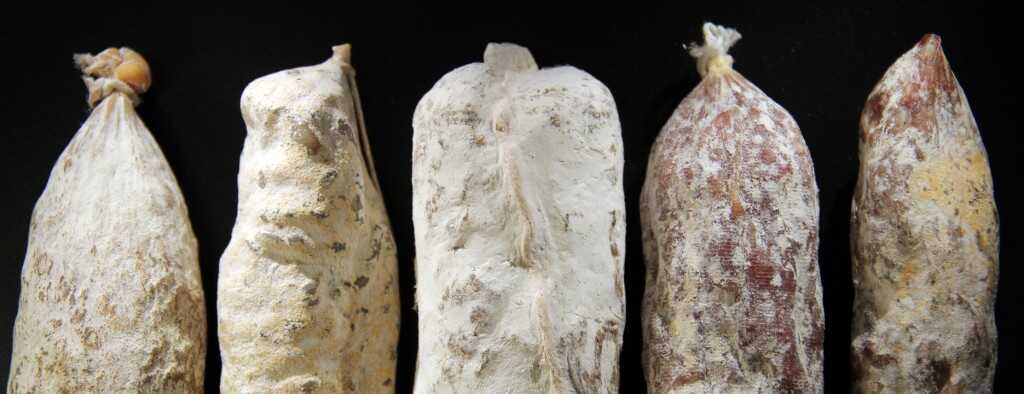
O mofo não intencional – que não foi adicionado propositalmente – no salame e em outros embutidos em geral é um sinal negativo, pois sua proliferação é muito rápida e a grande maioria das espécies não foram estudadas e produzem algum tipo de micotoxina.
Em geral, o mofo é tóxico e pode produzir substâncias hepatotóxicas, nefrotóxicas e carciogênicas. A maioria das espécies encontradas em salames é do tipo Penicillium e possui cor branca, que é considerado como um mofo inofensivo, mas variantes e outras espécies podem estar presentes e contaminar o produto.
A regra geral dentro da charcutaria é que o mofo branco e liso é seguro, qualquer outra alteração de cor ou um mofo com filamentos/pêlos ou pegajoso deve ser removido e o ambiente todo deve ser limpo. Mas nem todos querem arriscar, então todo e qualquer mofo pode ser removido para evitar possíveis riscos à saúde.
Em muitos países da Europa, como na Itália, os produtos com mofo são muito apreciados pelo sabor agregado, mas são países com tradição e excelência na manufatura artesanal, além disso os produtos são monitorados e maturados por longos períodos. No Brasil os produtos ou são industrializados, tradados com aditivos e maturados por pouco tempo ou são muito rústicos e com muito pouco controle higiênico. Infelizmente é muito difícil encontrar um produto bem maturado no Brasil.
Um fungo frequentemente adicionado ao salame é o Penicillium nalgiovense, que é seguro e agrega sabor aos produtos maturados por períodos prolongados. O fungo rapidamente coloniza a superfície impedindo que outras espécies nocivas proliferem. Recentemente cientistas da Dinamarca e Eslovênia identificaram um novo fungo encontrado em salames italianos. Esse novo fungo é derivado do Penicillium nalgiovense e foi nomeado de Penicillium salamii. É uma espécie que também é segura e possivelmente estará disponível comercialmente nos próximos anos.
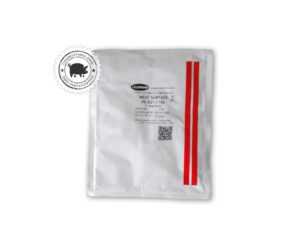
Diferentes espécies de fungos podem produzir um mesmo tipo de micotoxina, como também, uma única espécie de fungo pode produzir mais de um tipo de toxina. As principais micotoxinas encontradas em alimentos são: aflatoxinas, ácido fusárico, fumonisinas, ocratoxinas, patulina, citrinina, zearalenona e tricotecenos.
Os fungos não atingem apenas produtos cárneos, na verdade a FAO – Organização das Nações Unidas para a Alimentação e a Agricultura – estima que 25% de todos os grãos produzidos no mundo estejam contaminados com algum tipo de microtoxina, sendo a aflatoxina a mais comum.
O que é a Aflatoxina?
Aflatoxina é imunossupressora, mutagênica, teratogênica e carcinogênica. É produzida por certos fungos(principalmente o Aspergillus) encontrados em alimentos e rações, especialmente no milho e amendoim. É a toxina mais conhecida e estudada no mundo. Alguns países tentam regulamentar a exposição a esta toxina, exigindo que as produções para consumo sejam monitoradas. Essa prevenção é um dos grandes desafios toxicológicos dos tempos atuais.
O mofo pode crescer no refrigerador?
Sim! A maioria dos fungos prefere ambientes quentes, mas também podem prosperar em ambientes refrigerados. O mofo tolera ambientes com muito sal e açúcar diferentemente de outros invasores. O mofo pode proliferar em alimentos refrigerados como geléias, carnes salgadas e curadas como presuntos, bacon, salame e mortadela.
Alguns fungos conhecidos
A lista de fungos que podem prosperar na carne é grande, podemos citar o Alternaria, Aspergillus, Botrytis, Cladosporium, Fusarium, Geotrichum, Monilia, Manoscus, Mortierella, Mucor, Neurospora, Oidium, Oosproa, Penicillium, Rhizopus e Thamnidium.
Micotoxinas na legislação brasileira
Os alimentos comercializados no Brasil devem respeitar um limite máximo para a presença de micotoxinas, substâncias tóxicas produzidas por fungos e encontradas principalmente em grãos. É o que determina a Resolução RDC 07/2011, publicada pela ANVISA.
O que fazer com produtos mofados?
Abaixo estão as recomendações da USDA(United States Department of Agriculture) Food Safety and Inspection Service.
Presuntos, bacon ou salsichas
DESCARTE
Alimentos com alto teor de umidade podem ser contaminados abaixo da superficie. Esse alimentos podem conter também bactérias junto do mofo.
Salames e produtos com cura por secagem
LIMPE E USE
Remova todo o mofo da superficie. É normal para esses alimentos com secagem natural terem mofo na superfície, mas o interior seco é protegido.
Vegetais firmes(como repolho e cenoura)
REMOVA E USE
Corte ao menos 2,5cm em volta do ponto de mofo e cuide para a faca não passar pelo mofo e contaminar o restante.
Queijo duro
REMOVA E USE
Corte ao menos 2,5cm em volta do ponto de mofo e cuide para a faca não passar pelo mofo e contaminar o restante. Guarde em filme plástico novo. Mofo geralmente não penetra fundo nesses produtos.
Queijo feito com mofo(como Roquefort, azul, Gorgonzola, Brie, Camembert)
DESCARTE
Descarte caso contenham mofos que não façam parte do tradicionalmente adicionado na produção. Caso estejam em queijos duros(como o gorgonzola), proceda como nos queijos duros(acima).
Carne cozida, grãos, macarrão, queijo mole, iogurte e derivados, geléias, pão e assados, legumes, nozes, frutas e vegetais moles(como pepino, tomate e pêssego)
DESCARTE
Alimentos moles, porosos e industrializados que contenham mofo devem sempre ir para o lixo.
-
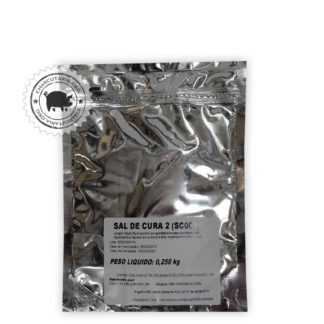 Sal de cura 2R$ 8,00
Sal de cura 2R$ 8,00 -
 Sal de cura 1R$ 8,00
Sal de cura 1R$ 8,00 -
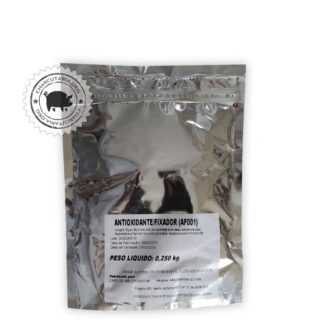 Antioxidante FixadorR$ 23,00
Antioxidante FixadorR$ 23,00 -
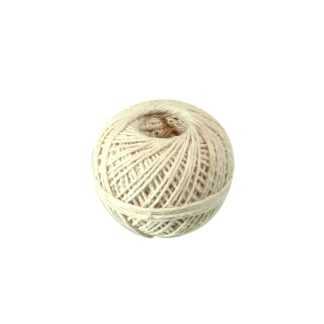 Barbante culinárioR$ 7,90
Barbante culinárioR$ 7,90 -
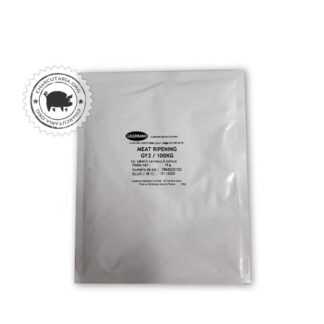 Cultura StarterO preço original era: R$ 69,90.R$ 59,90O preço atual é: R$ 59,90.
Cultura StarterO preço original era: R$ 69,90.R$ 59,90O preço atual é: R$ 59,90. -
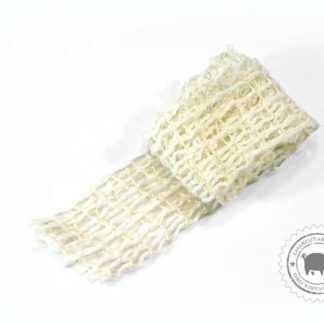 Rede elástica culinária 50mmR$ 15,00
Rede elástica culinária 50mmR$ 15,00 -
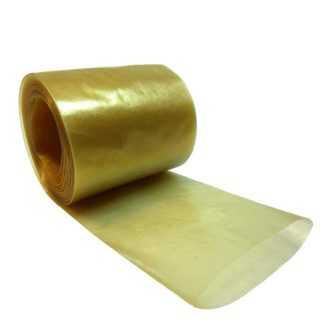 Tripa de colágeno 45mm rolo 5 metros salameR$ 25,00
Tripa de colágeno 45mm rolo 5 metros salameR$ 25,00 -
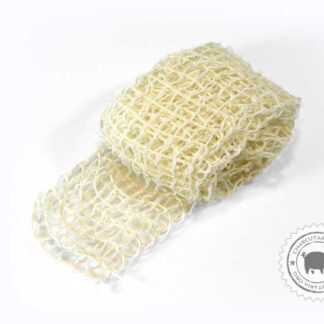 Rede elástica culinária 65mmR$ 18,00
Rede elástica culinária 65mmR$ 18,00 -
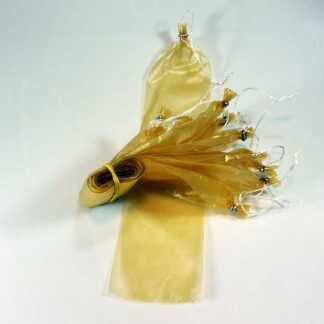 Tripa de colágeno salame 45mm 10 unidades amarradasR$ 22,00
Tripa de colágeno salame 45mm 10 unidades amarradasR$ 22,00 -
 Tripa de colágeno 80mm copa e salameR$ 29,90
Tripa de colágeno 80mm copa e salameR$ 29,90 -
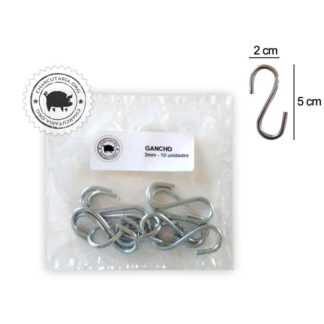 Gancho GalvanizadoR$ 12,00
Gancho GalvanizadoR$ 12,00 -
 Tripa de colágeno salame 50mm 10 unidades amarradasR$ 24,00
Tripa de colágeno salame 50mm 10 unidades amarradasR$ 24,00


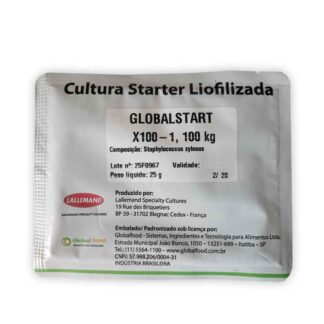
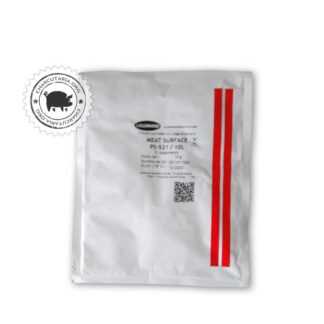
Estou produzindo salames mas eles estao ficando com a casca dura por fora em 7 dias e bem suculento e saboroso por dentro. Pra cortar é até dificil pq a casca esta ficando bem dura. O uso do mofo resolve isso ??
Oi Ana. O salame fica com a casca dura quando ele seca muito rápido. Normalmente ocorre por falta de umidade no ambiente ou por ventilação muito forte incidindo nos salames. Esses fatores causam exatamente o que citou, endurecem o salame por fora e mantém muito mole/cru no centro. Precisa aumentar a umidade e/ou reduzir o vento.
Boa tarde, sou novo na charcutaria e estou tentado fazer pela segunda vez presunto serrano, tenho uma geladeira com temperatura e umidade controla, porém meu presunto com 40 dias de maturação apresentou fungo branco tipo “algodão” em pequenos pedaços e fungo verde em outro pequeno pedaço, faço algo para retirar e limpar esses pedaços? Outra coisa tenho um salame em cura que está todo revestido de branco, posso coloca-lo próximo para auxiliar na propagação do fundo branco no presunto?
Oi Jorge, o mofo branco e mais fino, liso, regra geral, é um mofo inofensivo e até positivo por auxiliar no sabor e no controle da perda de peso, mas como não aplicou uma cultura de mofo específica, e relatou essa similaridade com o algodão, então fica difícil afirmar que seja um mofo bom ou alguma outra variação de cepas parecidas, mas, como dito, de forma geral o mofo branco geralmente é inofensivo. Sobre os outros pontos verdes, precisa limpar sim, o quanto antes pois pode espalhar. Esfregue uma escova ou pano com uma solução de água(200ml), sal(20g) e vinagre(2 colheres de sopa). Esfregue bem na região para remover e volte para a câmara. Repita se voltar a aparecer. Sobre o mofo branco do salames migrar para o presunto, sim, vai ocorrer, coloque-os próximos que um espalha para o outro. Para os próximos, pense com carinho em aplicar uma cultura de mofo penicilium nalgiovense, vai cobrir rápido e te dar mais tranquilidade.
Muito obrigado pela resposta, achei esse site após começar o presunto, com as dicas e produtos de vocês hoje eu já faria diferente. Grande abraço
Boa noite fizemos já tem uns 10 dias salame de carne de porco em casa para consumo próprio….mais ele começou na primeira semana soltar uma gosma na secagem e um mal cheiro horrível isso e normal?ele está bem seco agora porém o cheiro continua ainda nada agradável o que pode ter acontecido podemos deixar secar mais dias e consumir normalmente?
Olá, Andiara. Recomendo que limpe os salames esfregando água com vinagre e sal, isso vai ajudar a remover esse cheiro e proteger. O que pode fazer é defumar um pouco em temperatura bem baixa(defumação fria) para ajudar ainda mais na
proteção externa. Deixe secar mais um pouco executando esses procedimento que passei, depois avalie se ficaram melhores e o cheiro saiu.
Boa tarde!!!!irei fazer o recomendado vou te encaminhar uma foto de onde estão secando a noite sempre guardamos dentro de casa ….não consigo mandar foto para vc ver mais estamos secando em uma caixa com tela e já fiz o processo que vc recomendou sequei e coloquei novamente na caixa com tela para secar qtos dias para provar e ver se não estragou
Olá… Estou acompanhando o canal e o site há alguns dias e resolvi colocar em prática todo conhecimento que obtive assistindo os conteúdos e as leituras. Primeira vez que faço salame e como percebi que usar o Mold era uma forma melhor apliquei antes de colocar na adega para fermentação. Começou a aparecer o mofo branco, tirei uma fotografia só para saber se é assim que ele começa a nascer mesmo já que em salames com mais dias parece que ele fica mais seco. Gostaria de um Feedback só para saber se estou no caminho certo. Agradeço desde já a atenção e parabenizo pelo trabalho e conteúdo que transmitem.
Oi Pâmela. Está correto o desenvolvimento do mofo branco. Inicialmente ele é assim pela umidade do salame, depois vai ficando mais seco e fino conforme o produto vai secando. Vá acompanhando e, se tiver dúvidas, envie novamente uma foto.
ola estou produzindo salame e ele esta juntando um mofo amarelo e um pouco do branco, oque fazer para tirar esse mofo amarelo e conter so o branco, estou secando ele em um quartinho com um aparelho que solta vento e um pouco de aguá, será que eu devo colocar um ar condicionado?
Estou produzindo salame pela primeira vez, e com 15 dias de maturação em geladeira, com temperatura controlada, apareceu mofo. É seguro continuar com o processo, ou devo descartar a produção?
Estou produzindo um pernil curado maturado e começou a aparecer nas peças algo semelhante a esse fungo/levedura/bolor amarelo que tem na primeira imagem o último produto. Pode ser perigoso ou prejudicial ao processamento?
Oi Nayane. Há uma variedade imensa de fungos, cada um com suas características e substâncias liberadas. Para ter segurança o correto seria pedir uma análise laboratorial. Na dúvida é sempre recomendável limpar a área afetada e aplicar uma cultura de fungos específica, como a penicillium nalgiovense, ou um antifúngico para inibir novas contaminações. Para limpar esfregue um pano umedecido em água com sal e vinagre.
Obrigada!
Luiz antonio Boa tarde
Vou fazer o salame soppressata:
1 – Eu gostaria de não usar as Culturas penicilinium e starte tem algum problema.
2 – Quanto de tripa de colageno necessito para cada l quilo de carne
Oi Luiz Antonio.
1) O uso das culturas é opcional, pode fazer sem.
2) Depende do calibre da tripa, no calibre 45 vai usar 3 segmentos de 30cm de tripa para 1 kg de carne.
Olá!
Gostaria de saber qual seria o cheiro característico na maturação do salame.
Estou maturando a 15 dias e não sinto cheiro de salame, igual esses comprados.
Aguardo, obrigada!
Acho pouco tempo ainda. Normalmente se faz a cura das carnes. Depois em umidade um pouco mais alta, você deixa os fungos da cultura comprada, ou (há muita controvérsia, do yakult, Kefir, etc), se desenvolverem. Nesse tempo, já se passaram 20 dias no mínimo. Depois vem a maturação. O produto tem que perder 30 %, no mínimo. Um bom salame, três meses para merecer o nome.
Olá eu tenho uma dúvida
Entendo que o mofo se estabeleça na casca/pele do salame, mas do que é que ele se alimenta? Não pode ser da carne do salame ja que ela fica revestida, então o que é?
O mofo se alimenta de matéria orgânica. Tanto a tripa de colágeno quanto a tripa natural tem composição orgânica.
Oi, passei a solução que você indicou para parar o mofo porém em algumas peças ele prercistiu, o que devo fazer, reaplicar a solução?
O salame está perdendo em média 3% ao dia está normal ou muito acelerado?
Bom dia. O mofo reaparece mesmo, difícil eliminar por completo, tem que ir removendo até que o salame perca mais umidade e naturalmente reduza a suscetibilidade ao mofo. Para eliminar completamente o mofo pode usar o sorbato de potássio ou uma cultura mold. Com relação à perda de peso, aparentemente está acelerado, mas no início os produtos perdem peso mais rapidamente, depois fica mais lento pois há menos água disponível. Salames com calibre 50, por exemplo, levam cerca de 30 dias no total. Salames mais grossos, com calibre 60, por exemplo, levam 60 dias aproximadamente. Então precisa avaliar o tempo total com relação à perda. Evite vento direto sobre os salames e cuide bem da umidade, que deve ficar sempre perto dos 80%.
Muito obrigado vou seguir as dicas 👏👏
Boa noite, estou testando uma receita de presunto cru desde o dia 22/04/2021 e notei hoje que apareceu um mofo esverdeado. A carne estava embalada com ataduras, conforme mandava a receita. Gostaria de saber se esse mofo comprometeu todo o processo ou se tem uma maneira de limpá-lo pois o tempo de cura é de três meses.
Oi Luiz. A atadura esconde as contaminações, não recomendo usar. Pode usar colágeno ou fazer sem invólucro, que também dá certo. Sobre o que fazer com o mofo, depende muito da intensidade em que esse mofo foi propagado. Alguns tipos de mofos podem liberar toxinas nos alimentos. Caso a infestação tenha sido pontual e recente, pode remover esfregando água com sal, utilizando um pano, uma escovinha ou as mãos. Caso a infestação seja média, pode fatiar e descartar uma camada da região contaminada. Agora, caso esteja bem espalhado, neste caso recomendo que descarte a peça.
Boa tarde,
Posso embalar a vácuo o salame com o fungo branco ou tenho que tirar ele pra daí poder enviar no vácuo ?
Com certeza pode. Mas talvez as pessoas não entendam. Tem gente que tira a “casca” dos queijos Brie e Camenbert.
Quanto tempo leva para o fungo colonizar o salame ? Eu fiz há quase duas semanas e ainda não apareceu nada. Posso aplicar de novo? O salame está com aparencia boa, só falta o mofinho.
Geralmente em uma semana já começa a aparecer. O mofo desenvolve-se melhor em ambientes mais úmidos e com temperatura não tão baixa. Pode aplicar novamente, tentar manter a umidade alta e a temperatura um pouco mais alta até o mofo pegar.
Bom dia!! Qual o momento na produção do salame que pulverizo o mold 600? Na fermentação ou quando for colocar os salame na maturação?
Oi João, pode aplicar logo após embutir, durante a fermentação é um ótimo momento para que o mofo comece a proliferar. O mold 600 tem o penicilium nalgiovense, correto?
Bom dia!
Costumo produzir algumas copas e fazer a maturação em uma geladeira reservada para isso.
Na última leva apareceu um mofo cinza esverdeado.
Um produtor de embutidos me recomendou limpar com álcool 70%.
Poderia me informar se esta pratica é recomendada?
O que recomendamos é limpar bem as copas com uma solução de água(200ml), sal(10g) e vinagre(2 colheres de sopa). Depois pendure novamente e repita a operação caso volte a aparecer o mofo. Caso queira prevenir esse tipo de mofo pode aplicar uma cultura penicilium ou um antifúngico, como o sorbato de potássio.
Boa tarde,
fiz duas coppas, uma com canela, açúcar cravo e outra com alecrim, alho etc.
Para ambas usei 2,5% de sal de cura.
Depois do terceiro dia começou a apresentar mofo branco (alguns pontinhos), agora começou mofo branco tipo bolor (fiapos), e faz uns 4 dias que uma das coppa vem apresentando um cheiro ruim. Hoje completa 9 dias de maturação. Elas estão maturando no porão da minha casa em temperatura próxima de 18º e umidade acima de 80%. Qual ação posso tomar?
2,5% ou 0,25% de sal de cura? Sobre o mofo, remova o mofo esfregando nas copas uma solução de água(200ml), sal(10g) e vinagre(1 colher de sopa). Remova todo o mofo e pendure novamente. Repita o processo sempre que aparecer o mofo. Para resolver de forma mais eficiente o problema do mofo há duas alternativas, usar uma cultura mofo penicillium ou usar um antifúngico, como o sorbato de potássio.
Olá Eduardo, estou iniciando a charcutaria caseira . Fiz salame italiano caseiro com a seguinte formulação: carne 100%; 2% de açucar ; 1,5% de sal; alho em pó 1%; sal de cura 0,25%; yakult 2,0% e temperos secos , oregano , calabresa e reino. Hoje estou na fase de maturação ,que iniciei na parte de baixo de um refrigerador convencional e depois de uns 7 dias , passei para uma adega de vinho , com temperatura e umidade bem próximas dos parâmetros recomendados , temperatura entre 12° e 14° e umidade, um pouco menos de 75%. Agora, há 19 dias de maturação , ao abrir a adega , outra pessoa ( perdi paladar e olfato num tombo), sentiu um cheiro desagradável, de podre. Ato contínuo abri uma das peças , estava coberta por um fungo branco , seco sem esporos , continuo , não se via a tripa.
Oi Ronald. Pelo descrição o mofo branco é o benéfico. O cheiro não deve ser de podre, no máximo um cheiro um pouco ácido da fermentação. Usou papel vegetal?
Oi Eduardo, obrigado pelo retorno, sim usei papel vegetal. Estou preocupado com a fase de fermentação, única fase do fabrico de salame que ocorre fora de refrigeração, fermentação essa que ocorreu por 2/3 dias, em temperatura de 20/25 °C, dentro de casa, pendurado numa gaiola telada, usada para fazer carne de sol . A UR , foi sem controle , já que, aqui no Rio Grande do Sul, o inverno é bastante úmido. De qualquer forma , lavei as peças com a solução que indicastes para alguém nesta seção , embalei de novo em papel manteiga e retornei à adega de vinho onde estou maturando , agora então , com o controle de em termo-higrômetro. Mais uma semana devo concluir a maturação , só que , estou com medo de provar e pegar alguma intoxicação do tipo botulismo. Que sugeres ? Obrigado.
Oi Ronald. Com o controle de umidade não precisa do papel manteiga, ele só vai atrapalhar pois cria uma barreira extra que, dependendo do papel, pode ser impermeável. Tire do papel e deixe pendurado na adega. Na próxima faça desde o início sem o papel, na adega. O botulismo é proveniente de contaminação bacteriana, então o mofo não causaria esse problema. Como usou o sal de cura então é bem improvável que tenha havido proliferação da bactéria do botulismo, pois é um dos patógenos inibidos pelo sal de cura. Outro fator é o yakult, que acidifica o salame e também protege. O mofo que citou, pela descrição, branco e liso/fino, é o mofo inofensivo.
Ok. Obrigado pela atenção.
Oi Eduardo, estas são as peças do salame de que falamos acima, abertos após 32 dias de maturação e 3 dias de fermentação, perda 40% de umidade, cheiro diminuiu na adega, nas peças, cheiro forte, não de podre. Ainda ,um pouco de umidade interna, . Na foto , se nota falta de uma boa compactação. Será que foi UR muito baixa , ocorrendo uma secagem superficial muito rápida , dificultando a secagem interna ? mesmo meio úmido, pode ser consumido ?
Oi Ronald. Uma possibilidade é essa, umidade baixa na câmara, ressecando excessivamente e exterior, criando uma barreira que impediu a água do miolo migrar para fora. Mesmo úmida ela pode ser consumida, os salames coloniais do sul do Brasil são bem úmidos. São consumidos úmidos mesmo ou grelhados com polenta!
OK. Obrigado . Abraço
Boa tarde, hoje fui abrir um salame que estava com 40% de perda na camara de maturação e estava com mofos verdes em várias partes dele (fez um buraco interno com bastante mofo verde). Mas do lado de fora não tinha nenhum sinal de mofo. Queria saber o que acha que pode ter acontecido e se acha seguro comer as partes que estão sem o mofo. Obrigado novamente
No início da fermentação estava com um vento um pouco forte demais, acha que isso pode ter secado o exterior muito rápido e com isso ter criado um ambiente interno favorável à proliferação do fungo? Usamos a cultura T-SPX, mas acabamos diluindo errado e usamos em pouca quantidade.
No mesmo dia que produzimos esse salame de calibre 45, fizemos também um de calibre 21 (estilo salamitos) que ficou muito bom e um hamburgues calibre 60 que ainda não abrimos. Possivelmente todos estarão contaminados né? Devo jogar fora e limpar a geladeira antes de colocar outros salames? Minha dúvida é porquê como não tinha nada na superfície do salame não sei se está no ambiente da geladeira podendo contaminar outros.
Felipe, não necessariamente todos estarão contaminados. O mofo está em todos os lugares, os esporos vagam pelo ar, então livre mesmo é difícil mesmo usando uma sala com entrada de ar filtrada. Por fora não proliferou pois, provavelmente, o ambiente não foi favorável, vento forte e ambiente seco talvez. Jogue fora caso note contaminação como neste que abriu e estava infestado por dentro. Se os outros ficaram bem compactados, sem ar interno, provavelmente não terão o mesmo problema. Tente embutir os próximos com a massa mais compactada, sem bolsões de ar.
Oi Felipe, creio que foi pouco compactado ao embutir e entrou muito ar, parte dele contaminado com esse mofo. O problema do mofo são as toxinas que ele pode, recomendo que descarte. CAso queira experimentar, coma de uma área bem distante desta contaminação.
Bom dia, eu estou começando na charcutaria transformei uma geladeira em câmara de maturacao fiz alguns salames e borrifei o mofo estão todos brancos do mofo. No momento estou fazendo copa e minha dúvida é se precisa borrifar o mofo na copa pois ela vai para câmara e lá já está repleto do mofo branco, é necessário colocar o mofo na copa ou não?
Oi Francisco. Como o mofo já proliferou nos salames então provavelmente a copa “pegue” o mofo sem a necessidade de aplicar novamente. Mas, caso queira garantir a cobertura do mofo benéfico, então aplique novamente. Não há problemas em aplicar novamente.
Obrigado pela dica
Olá!! Bom dia fizemos alguns salames em casa para consumo próprio, e após todo o processo ja estando pronto e maturado e limpo ele está formando uns fungos branco e não é no salame todo isso é comum tem algum produto que vocês indicam pra eliminar isso? Obrigada
Oi Cintia. Mofo é um problema comum. Para inibir o mofo pode usar um produto chamado natamicina ou utilizar uma cultura do tipo mofo(penicillium), que é aplicada no exterior dos salames já embutidos. Esse mofo aplicado toma conta dos salames e inibe o aparecimento de outros mofos maléficos. Já a natamicina é um antifúngico químico que alguns usam na massa do salame e outros limpam o ambiente de maturação.
Vou passar para o meu esposo as informações, muito obrigada pela atenção.
A Cultura T-SPX é boa na produção de salames? indica o uso dela? Um amigo se mudou e me deu a dele, mas vi que a composição é diferente da que vocês tem aqui no site. Alguma dica sobre?
Obrigado
Oi Felipe, tem que ver a composição, pelo que sei a T-SPX é um pouco menos completa, tem uma gama menor de bactérias e consequentemente um leque menor de benefícios. Mas precisaria conferir a composição para poder fazer uma comparação mais precisa.
Bom dia, obrigado pela resposta!
A composição é Pediococcus pentosaceus e Staphylococcus xylosus. Essa segunda tem na que vocês vendem aqui também né (esgotada e o frete fica mais de 10 dias). Essa primeira deve ser fermentadora com ação protetora né?
Sim, a Pediococcus pentosaceus é formadora de ácido lático, trabalha na proteção.
Bom dia!! Estou produzindo presuntos de porcos mouros.Fiz todo o processo de salga, camara fria, e agora estao em um secador natural com controle de humidade etc..Nas peças apareceram umas pintas pretas minusculas.Isso acredito ser do proprio processo de cura.Estou certo ou devo me preocupar?
Oi Mario, se puder enviar uma foto fica mais fácil tentar avaliar.
Bom dia!!!
Estou fazendo uma copa, deixei 15 dias na geladeira com sal, sal de cura 2 e açúcar. Agora coloquei os temperos e a cultura starter para fermentação, em uma adega controlando a temperatura e a umidade, porém estou achando um cheiro bem forte. Isto é normal? Será por conta da cultura que borrifei no externo da copa?
Obrigado
Também apareceu um pouco de modo branco com pelos. O que devo fazer?
O processo de limpeza com o pano umedecido em água com sal e um pouco de vinagre vai remover esse mofo e ajudar a proteger. Pode repetir o processo sempre que achar necessário.
Oi Douglas. Limpe bem a copa esfregando um pano umedecido em água com sal e um pouco de vinagre. Continue o processo e veja se o cheiro passa.
Olá Eduardo! Me ajude com uma duvida: posso fermentar os salames em uma caixa de isopor aquecida com uma lampada para chegar em +- 25º e umidade a 90% até chegar na acidez necessária e depois partir para a maturação? Essa caixa pode ser bem limpa com álcool ou ele seria prejudicial a fermentação de alguma forma? Parabéns pelo seu trabalho !! Obrigado
Pode sim, sem problemas, depois transfira para o ambiente com temperatura baixa.
Mais uma pergunta: a caixa de isopor tem problema se ela ficar fechada, pois tenho medo de deixar aberta e ela contaminar. Ela precisa ter ventilação dentro? Ou posso fechar com um tecido bem fino para a passagem do ar? Obrigado de novo!
Durante a fermentação pode deixar fechada, depois que é necessário circular ar. Pode fechar com a tampa ou com tecido, como preferir.
Obrigado Eduardo!
Meu salame esta quinze dias curando e perdendo peso normalmente… fiz 2, um curando na geladeira com papel manteiga e outro secando em ambiente arejado… porém nenhum dos dois criou o mofo branco… o que fazer?
Oi Hugo, não há problema nisso. O mofo branco só é desejado quando é aplicada a cultura mofo penicillium, caso contrário o ideal é que não haja mofo durante o processo. O mofo branco é opcional e serve para inibir que outros fungos indesejados proliferem no salame.
Mesmo usando leite fermentado?
Sim, o leite fermentado(bactérias láticas) não vai influenciar no revestimento branco(que é um mofo). São microrganismos diferentes.
…
Olá, bom dia! Então, eu fiz um salame sendo que não usei sal da cura. E esses três primeiros dias eles estão com um cheiro não muito agradável, isso é normal? E tb não os deixei em local escuro.. obrigado!
Quanto de sal comum usou? Limpe bem o salame esfregando um pano umedecido em água com sal e um pouco de vinagre. Continue o processo e veja se o cheiro passa.
Não usei muito, mas tb usei vinho e um pouco de açúcar.. farei e manterei o processo.. obrigado! Minha primeira vez.. rs
Bom dia!! Acho que vou descartar os salames.. eles estão com um cheiro bem forte de “estragado”, pode não ser, mas tá bem forte.. sei que o cheiro do processo não é assim.. vc me indicaria isso tbm? Muito obrigado
Oi Guilherme. Acredito que possa tentar limpar bem os salames e prosseguir apenas como experiência, para ver o andamento do processo. Caso após alguns dias depois da limpeza os salames continuem cheirando mal, descarte!
Olá, tudo bom?!
Estou com um Salame por aproximadamente 100 dias na Câmara e só agora está chegando aos 43% de perda de peso. Saberia me informar se eu o perdi ou ainda pode ser consumido? Em teoria ele deveria chegar com essa mesma perda em 30-45 dias.
Obs 1: Deixei 24hs “Enxugamento”
Entrada na Câmara para secagem com 500g
Hoje aprox. 100 dias está com 287g.
Obs2: Ele está frequentemente aparecendo mofos lisos e brancos, que no meu ver não é maléfico.
Obrigado desde já!
Oi Igor. Com relação ao tempo não há problema. Salames com calibres mais altos tendem a precisar ficar bastante tempo na câmara até ficarem bem firmes por completo. Depende muito das condições do ambiente, principalmente a umidade e a ventilação. Vai desenvolver bem o sabor com essa maturação longa. Com 43% de perda acredito que já esteja bom para finalizar o processo e consumir.
Sobre o mofo, pela foto parece ser o mofo inofensivo do tipo penicillium, está bem bonito. Antes de consumir recomendo que limpe bem em água corrente, tire a tripa toda, passe um azeite para proteger e dar um brilho bonito, envolva bem em pvc ou à vácuo e armazene na geladeira.
Resolvi finalizar com os 43% mesmo, não aguentei esperar por mais tempo. rsrsrs’
E olha, ficou muito bom… Todo mundo daqui de casa gostou. 😉
Vou utilizar com bastante frequência sua página, pois possui conteúdos bons e explicativos, além do retorno e ajuda quase que instantânea.
Grato! 😉
Oi Igor. Com 43% de perda já fica em um ponto ótimo. Com menos de 40% que para o meu gosto fica ainda muito mole. Abraços!
Olá…Estou com uma dúvida. Tenho uma copa q inicialmente apresntou mofo branco, agora apareceram mofo verde. Já perdeu aproximadamente 25% do peso. O que devo fazer?
Oi Cintia. Lave bem a copa esfregando um pano umedecido em água(200ml), sal(10g) e vinagre(uma colher de sopa). Esfregue bem até remover todo o mofo indesejado e pendure novamente. Repita este procedimento sempre que surgir algum mofo indesejado.